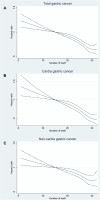The association between poor dental health and gastric cancer risk: a nationwide cohort and sibling-controlled study
- PMID: 40691605
- PMCID: PMC12282018
- DOI: 10.1186/s12916-025-04273-x
The association between poor dental health and gastric cancer risk: a nationwide cohort and sibling-controlled study
Abstract
Background: Poor dental health has been linked to an increased risk of gastric cancer (GC), but previous studies were limited by their retrospective design and relatively small sample size.
Methods: We followed a nationwide cohort of 5,888,034 Swedish adults over the age of 19 who visited a dentist between 2009 and 2016. Additionally, a nested case-control study was conducted by comparing incident GC cases to their siblings. Cox regression analyses, using attained age as the timescale and adjusting for potential confounders, were performed to evaluate the association between various dental health conditions and the risk of GC. In addition, we stratified our analyses by sex and age and conducted various sensitivity analyses to ensure the robustness of our findings.
Results: Over an average follow-up of 6.4 years, we identified 3993 new GC cases, including 1241 cardia GC and 2752 non-cardia GC. Compared to individuals with healthy teeth, those with periodontitis had an 11% and 25% increased risk of GC and cardia GC, respectively. The positive associations between odontogenic inflammation and the risk of GC were consistent in sibling-controlled analyses. We also observed a dose-response relationship between the number of remaining teeth and the risk of GC, with fewer teeth associated with higher risks. Additionally, we did not find significant interactions between dental inflammatory conditions and the number of remaining teeth in relation to the risk of GC or its subtypes. Our findings were consistent across different sex and age subgroups and in sensitivity analyses.
Conclusions: This study provides the largest prospective cohort study evidence to date, along with the first sibling-controlled comparisons, supporting the association between poor dental health and GC risk. Promoting dental health in the general population could have significant public health implications in preventing this disease.
Keywords: Cohort study; Dental health; Gastric cancer; Population-based; Register-based; Sibling-controlled.
© 2025. The Author(s).
Conflict of interest statement
Declarations. Ethics approval and consent to participate: This study was performed in line with the principles of the Declaration of Helsinki. Approval was granted by the Ethical Review Board in Stockholm, Sweden (approval number: 2021–02491). Informed consent was waived due to the nature of registry data. Consent for publication: Not applicable. Competing interests: The authors declare no competing interests.
Figures




Similar articles
-
Selenium for preventing cancer.Cochrane Database Syst Rev. 2018 Jan 29;1(1):CD005195. doi: 10.1002/14651858.CD005195.pub4. Cochrane Database Syst Rev. 2018. PMID: 29376219 Free PMC article.
-
[Volume and health outcomes: evidence from systematic reviews and from evaluation of Italian hospital data].Epidemiol Prev. 2013 Mar-Jun;37(2-3 Suppl 2):1-100. Epidemiol Prev. 2013. PMID: 23851286 Italian.
-
Topical fluoride as a cause of dental fluorosis in children.Cochrane Database Syst Rev. 2024 Jun 20;6(6):CD007693. doi: 10.1002/14651858.CD007693.pub3. Cochrane Database Syst Rev. 2024. PMID: 38899538 Free PMC article.
-
Interventions for central serous chorioretinopathy: a network meta-analysis.Cochrane Database Syst Rev. 2025 Jun 16;6(6):CD011841. doi: 10.1002/14651858.CD011841.pub3. Cochrane Database Syst Rev. 2025. PMID: 40522203
-
Direct composite resin fillings versus amalgam fillings for permanent posterior teeth.Cochrane Database Syst Rev. 2021 Aug 13;8(8):CD005620. doi: 10.1002/14651858.CD005620.pub3. Cochrane Database Syst Rev. 2021. PMID: 34387873 Free PMC article.
References
-
- Thrift AP, Wenker TN, El-Serag HB. Global burden of gastric cancer: epidemiological trends, risk factors, screening and prevention. Nat Rev Clin Oncol. 2023;20(5):338–49. - PubMed
MeSH terms
Grants and funding
LinkOut - more resources
Full Text Sources
Medical
Miscellaneous

